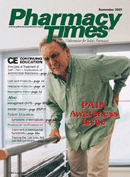A closer look at new FDA actions: Novartis' Tekturna
Dr. Holmberg is a pharmacy resident at the Carl T. Hayden Veterans Affairs Medical Center in Phoenix, Ariz.
Novartis? TekturnaFor the first time in over 10 years, anantihypertensive medication of a newclass has received approval from the FDA for the treatment of hypertensionin adult patients.1 Novartis? Tekturna(aliskiren) is described as a direct renininhibitor and is the first in this new classof antihypertensive medications to beapproved.2Approximately 25% of Americansare affected by hypertension.1,2Worldwide, this value rises to almost1 billion individuals, 70% of whomremain inadequately treated.2 Calledthe silent killer, hypertension oftenremains asymptomatic until majordamage is already done to the body.Complications of hypertension caninclude increased risk of stroke,heart attack, kidney failure, heart failure,and death.1Tekturna is a once-daily treatment andmay be used either as monotherapy or inconjunction with other antihypertensivemedications. Its use with high-doseangiotensin-converting enzyme (ACE)inhibitors has not been studied extensively.3Mechanism of ActionTekturna?s direct inhibition of reninsecretion from the kidney prevents theconversion of angiotensinogen to angiotensinI. Angiotensin I is a precursor toangiotensin II; without angiotensin I, theproduction of angiotensin II is not possible.Angiotensin II is a peptide responsiblefor raising blood pressure throughcatecholamine release, aldosteronesecretion, and sodium reabsorption.Thus, preventing the formation ofangiotensin II results in decreased bloodpressure.3Clinical Trials
Six randomized, double-blind, placebo-controlledclinical trials studiedTekturna?s safety and efficacy for 8weeks in patients with mild-to-moderatehypertension. Doses ranged from 150 to600 mg daily. At the studies? end,Tekturna was determined to be moreeffective than placebo. Doses of 150 or300 mg daily were found to be the mostreasonable; doses above 300 were notfound to be any more effective than the300-mg dose.
Some patients continued the study asopen-label for up to a year. A significantdifference in blood pressure was foundin patients using Tekturna, comparedwith those using placebo; on discontinuingtreatment with Tekturna, patients?blood pressure returned to baseline aftera few weeks.3Warnings
Tekturna carries a boxed warningagainst its use in pregnancy. Whenadministered to a pregnant woman,drugs that work directly on the reninangiotensinsystem have been shown tocause harm or even death to the fetus.As a result, Tekturna should not be usedduring pregnancy, and patients should beeducated to communicate with theirhealth care provider if they are or plan tobecome pregnant.
Some patients using Tekturna experiencedangioedema of the face, extremities,lips, tongue, glottis, and/or larynx.This reaction may occur at any time duringtreatment with Tekturna. Shouldangioedema occur, Tekturna should bediscontinued immediately, and thepatient should receive appropriate supportivecare and monitoring.
Hypotension occurred rarely inpatients using Tekturna alone or in additionto other antihypertensive medications;however, volume-depleted or salt-depletedpatients may be at a greaterrisk for developing hypotension after initiatingtreatment with Tekturna. Monitoringand supervision may beappropriate for these patients.3PrecautionsTekturna was not studied inpatients with renal dysfunction, asdefined as creatinine 1.7 mg/dL forwomen or 2.0 mg/dL for men and/orestimated glomerular filtration rate<30 mL/min. Tekturna was not foundto cause hyperkalemia when administeredalone; hyperkalemia wasnoted in patients using Tekturna in combinationwith an ACE inhibitor.Tekturna is metabolized by CYP3A4.Tekturna levels were noted to beincreased significantly when administeredconcomitantly with atorvastatinand ketoconazole and lowered whenadministered with irbesartan. Concomitantuse of furosemide and Tekturnahas resulted in decreased furosemidelevels.3Adverse ReactionsIn clinical trials, the most commonadverse reaction was diarrhea. Otherreactions included cough and rash.1References
1. Tekturna?the first new type of high blood pressure medicine in more than a decade?receives its first approval in the US [press release]. East Hanover, NJ: Novartis Pharmaceuticals Corp; March 6, 2007. Available at: www.pharma.us.novartis.com/newsroom/pressReleases/releaseDetail.jsp?PRID=2019. Accessed June 2007.
2. FDA approves new drug treatment for high blood pressure [press release]. Rockville, Md: FDA; March 6, 2007. Available at: www.fda.gov/bbs/topics/NEWS/2007/NEW01580.html. Accessed June 2007.
3. Tekturna [package insert]. East Hanover, NJ: Novartis Pharmaceuticals Corp; 2007. Available at: www.pharma.us.novartis.com/product/pi/pdf/tekturna.pdf. Accessed June 2007.

